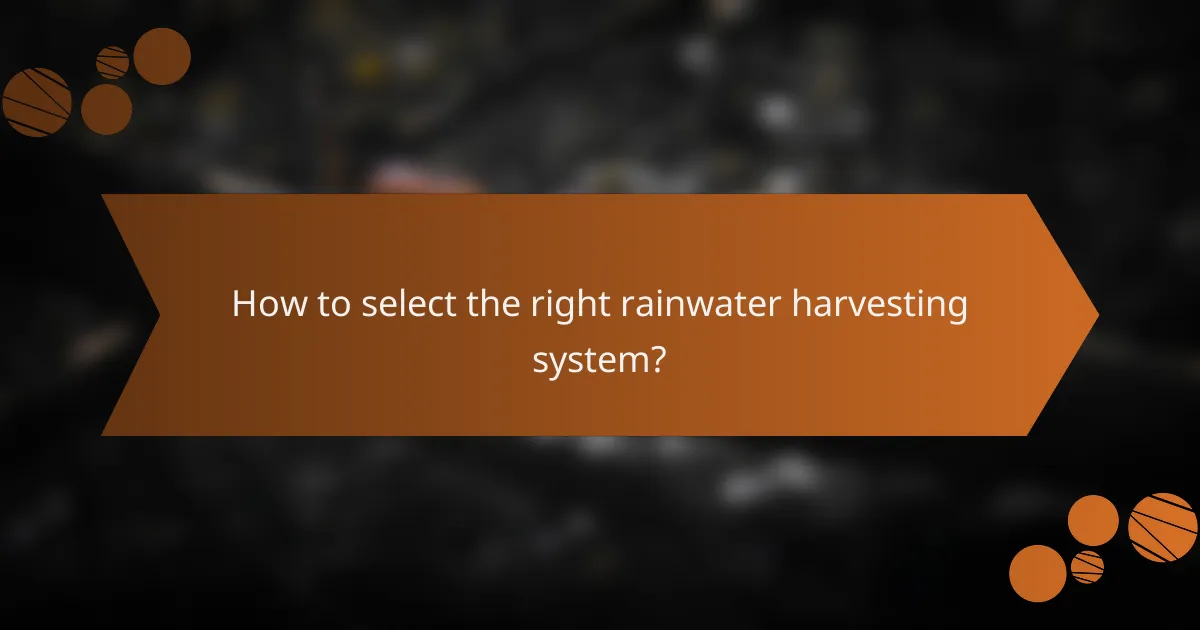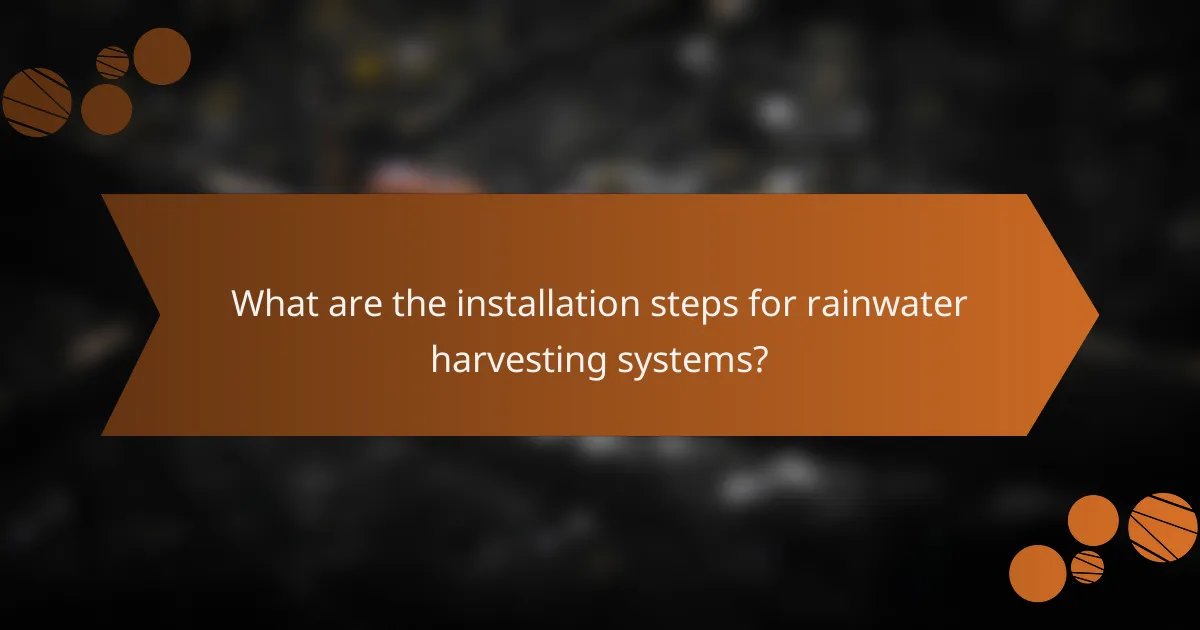Rainwater harvesting systems offer urban areas a sustainable solution for water conservation, enabling efficient use of natural resources while reducing dependency on municipal supplies. Selecting the appropriate system requires careful consideration of factors such as water demand, available space, and local regulations. Proper installation and maintenance are essential to ensure these systems function effectively and comply with legal standards.

What are the benefits of rainwater harvesting systems in urban areas?
Rainwater harvesting systems in urban areas provide significant advantages, including efficient water conservation, cost savings, and improved environmental management. These systems capture and store rainwater for various uses, reducing reliance on municipal water supplies and minimizing stormwater runoff.
Water conservation
Rainwater harvesting systems play a crucial role in water conservation by collecting rainwater that would otherwise be lost to runoff. This stored water can be used for irrigation, toilet flushing, and other non-potable applications, significantly reducing the demand on local water supplies. In urban settings, where water scarcity can be a concern, these systems help ensure a sustainable water source.
Implementing a rainwater harvesting system can lead to a reduction in overall water consumption by up to 50% in some households, depending on usage patterns and system efficiency.
Cost savings
Utilizing rainwater can lead to substantial cost savings on water bills, especially in areas with high water rates. By capturing and using rainwater for irrigation and other non-potable uses, homeowners can decrease their reliance on municipal water sources, resulting in lower monthly expenses. Additionally, many regions offer incentives or rebates for installing rainwater harvesting systems, further offsetting initial costs.
Investing in a rainwater harvesting system can yield a return on investment within a few years, depending on local water costs and the system’s size.
Environmental impact
Rainwater harvesting systems contribute positively to the environment by reducing stormwater runoff, which can lead to erosion and water pollution. By capturing rainwater, these systems help recharge groundwater supplies and maintain local ecosystems. Moreover, they can mitigate the urban heat island effect by reducing the amount of water that must be treated and transported through municipal systems.
Incorporating rainwater harvesting can enhance urban biodiversity by providing a reliable water source for gardens and green spaces, promoting healthier urban environments.
Stormwater management
Effective stormwater management is critical in urban areas, where impervious surfaces can lead to flooding and drainage issues. Rainwater harvesting systems can alleviate these problems by capturing excess rainwater, thus reducing the volume of runoff entering storm drains. This not only helps prevent flooding but also minimizes the risk of combined sewer overflows, which can contaminate local waterways.
Implementing a rainwater harvesting system can be part of a broader stormwater management strategy, integrating with green roofs, permeable pavements, and bioswales to enhance urban resilience.
Increased property value
Installing a rainwater harvesting system can increase property value by making a home more sustainable and appealing to environmentally conscious buyers. Properties equipped with efficient water management systems often stand out in the market, attracting buyers looking for energy-efficient and cost-saving features. This investment can enhance the overall marketability of a property.
In some regions, homes with rainwater harvesting systems may command higher resale prices, reflecting the growing demand for sustainable living solutions.

How to select the right rainwater harvesting system?
Selecting the right rainwater harvesting system involves assessing your specific needs, including water demand, available space, and local regulations. Key factors such as system size, material durability, and maintenance requirements will significantly influence your choice.
System size and capacity
The size and capacity of your rainwater harvesting system should align with your water usage needs. Consider factors like the size of your roof, average rainfall in your area, and the intended use of the collected water, such as irrigation or household use.
A common guideline is that a system should ideally capture enough water to meet at least 50-100% of your non-potable water needs. For example, a family of four may require a system that can store several thousand liters, depending on their consumption patterns.
Material and durability
The materials used in your rainwater harvesting system can affect its longevity and performance. Common materials include plastic, concrete, and metal, each with varying durability and cost implications.
Plastic tanks are lightweight and resistant to corrosion, while concrete tanks offer durability but can be more expensive. Evaluate the local climate and potential exposure to elements when selecting materials to ensure long-term reliability.
Local regulations and permits
Before installing a rainwater harvesting system, check local regulations and permit requirements. Some regions have specific guidelines regarding system design, installation, and water quality standards.
In the United States, for instance, many states encourage rainwater harvesting but may require permits or adherence to specific codes. Consulting with local authorities can help you avoid fines and ensure compliance with all regulations.
Maintenance requirements
Establish a maintenance schedule, ideally every six months, to ensure that your system operates effectively. Neglecting maintenance can lead to reduced water quality and system failures, which can be costly to repair.

What are the installation steps for rainwater harvesting systems?
The installation of rainwater harvesting systems involves several key steps, including site assessment, system design, installation, and ongoing maintenance. Each step is crucial for ensuring the system operates efficiently and meets local regulations.
Site assessment
The first step in installing a rainwater harvesting system is conducting a thorough site assessment. This involves evaluating the roof area, drainage patterns, and local climate to determine the potential for rainwater collection. Consider factors such as the type of roofing material, surrounding vegetation, and any local regulations regarding rainwater harvesting.
During the assessment, it is also important to identify the best location for the storage tank, ensuring it is easily accessible for maintenance and complies with any zoning laws. Soil conditions should be checked as well, particularly if the system includes infiltration methods.
System design
Once the site assessment is complete, the next step is to design the rainwater harvesting system. This includes selecting the appropriate components, such as gutters, downspouts, filters, and storage tanks. The design should account for the expected rainfall in the area and the intended use of the harvested water, whether for irrigation, toilet flushing, or other non-potable uses.
Consideration should also be given to the size of the storage tank, which typically ranges from a few hundred to several thousand liters, depending on the roof area and water demand. Additionally, ensure that the design meets any local codes or standards for rainwater harvesting systems.
Installation process
The installation of the rainwater harvesting system involves several steps, starting with the installation of gutters and downspouts to collect rainwater from the roof. These should be securely fastened and sloped correctly to ensure efficient water flow. Next, install the filtration system to remove debris and contaminants before the water enters the storage tank.
After the collection system is in place, the storage tank should be installed in the chosen location, ensuring it is level and stable. Connect the tank to the filtration system and any additional plumbing required for distribution. It is advisable to hire a professional for this stage to ensure compliance with local regulations and proper installation techniques.
Testing and maintenance
After installation, it is essential to test the rainwater harvesting system to ensure it functions correctly. Check for leaks, proper water flow, and the effectiveness of the filtration system. Regular maintenance is crucial for the longevity and efficiency of the system, which includes cleaning gutters, inspecting filters, and checking the storage tank for sediment buildup.
Establish a maintenance schedule, ideally every six months, to keep the system in optimal condition. Additionally, monitor local regulations for any changes that may affect the operation or maintenance of your rainwater harvesting system.

What permits are required for rainwater harvesting in California?
In California, rainwater harvesting typically requires a permit, especially for systems designed to collect and store significant amounts of water. Homeowners should check with local authorities to understand specific requirements and ensure compliance with state regulations.
State regulations
California state regulations mandate that any rainwater harvesting system must comply with the California Plumbing Code and the California Health and Safety Code. These regulations ensure that collected rainwater is safe for use, particularly if it is intended for potable applications. Homeowners should familiarize themselves with these codes to avoid potential legal issues.
Additionally, the state encourages rainwater harvesting by providing guidelines for system design, installation, and maintenance. These guidelines help ensure that systems are efficient and environmentally friendly.
Local building codes
Local building codes in California can vary significantly by municipality, so it is crucial to consult local authorities before installing a rainwater harvesting system. Many cities have specific requirements regarding the size, type, and installation of rainwater collection systems, which may include setbacks from property lines and limitations on tank size.
Some local jurisdictions may also require inspections or additional permits for installation. Checking with local building departments can help ensure that all necessary permits are obtained and that the system complies with local standards.
